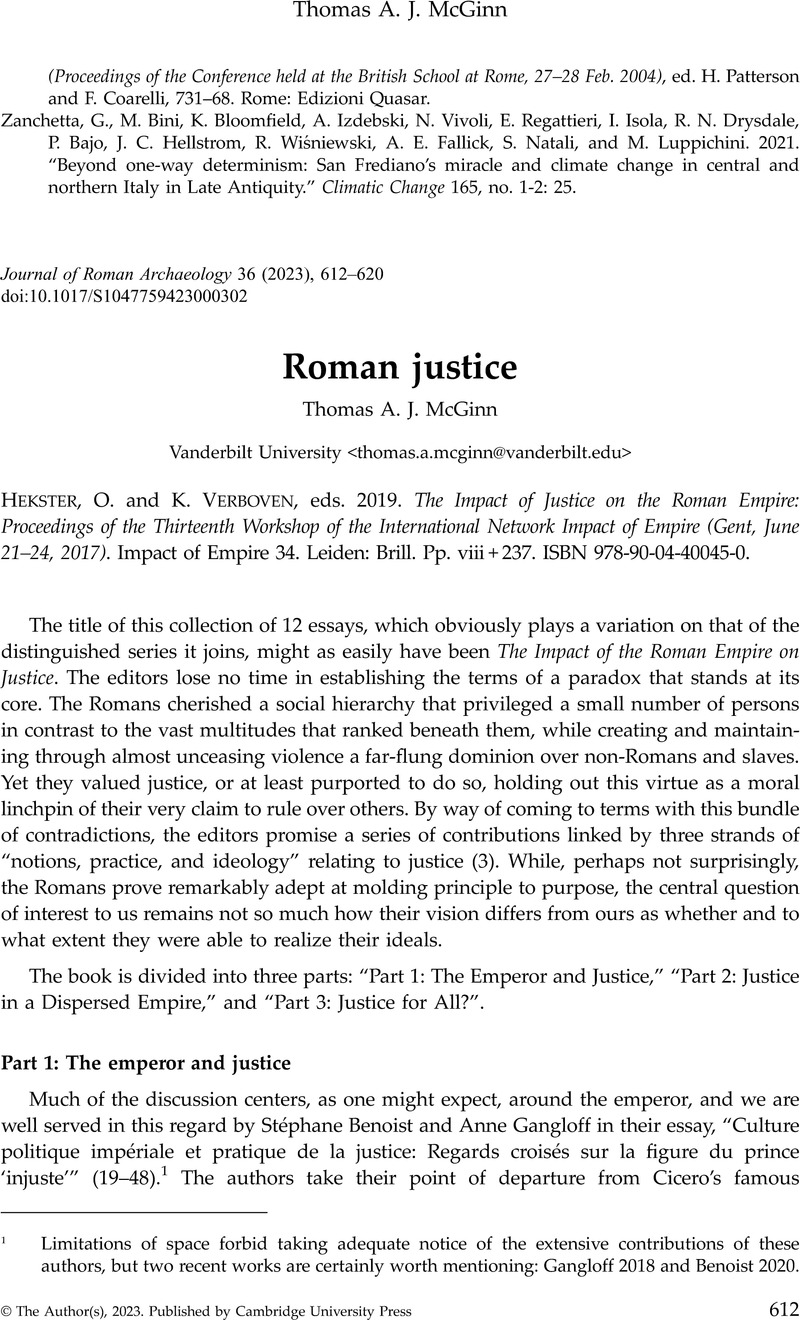No CrossRef data available.
Article contents
Roman justice - O Hekster. and K. Verboven, eds. 2019. The Impact of Justice on the Roman Empire: Proceedings of the Thirteenth Workshop of the International Network Impact of Empire (Gent, June 21–24, 2017). Impact of Empire 34. Leiden: Brill. Pp. viii + 237. ISBN 978-90-04-40045-0.
Review products
O Hekster. and K. Verboven, eds. 2019. The Impact of Justice on the Roman Empire: Proceedings of the Thirteenth Workshop of the International Network Impact of Empire (Gent, June 21–24, 2017). Impact of Empire 34. Leiden: Brill. Pp. viii + 237. ISBN 978-90-04-40045-0.
Published online by Cambridge University Press: 31 August 2023
Abstract
An abstract is not available for this content so a preview has been provided. Please use the Get access link above for information on how to access this content.

- Type
- Book Review
- Information
- Copyright
- Copyright © The Author(s), 2023. Published by Cambridge University Press
References
Coleman, K. M. 1990. “Fatal charades: Roman executions staged as mythological enactments.” JRS 80: 44–73.Google Scholar
Daalder, E. S. 2018. De rechtspraakverzamelingen van Julius Paulus: Recht en rechtvaardigheid in de rechterlijke uitspraken van keizer Septimius Severus. Den Haag: Boom Juridisch.Google Scholar
Daalder, E. S. 2022. “Aequum putavit imperator: Imperial representation and juristic self-fashioning in the Decreta and Imperiales Sententiae of Julius Paulus.” ZSav 139: 123–91.Google Scholar
Gangloff, A. 2018. Pouvoir impérial et vertus philosophiques: l’évolution de la figure du bon prince sous le Haut-Empire. Leiden: Brill.10.1163/9789004379374CrossRefGoogle Scholar
Johnston, D. 2022. Roman Law in Context. 2nd ed. Cambridge: Cambridge University Press.10.1017/9781108572873CrossRefGoogle Scholar
Marrou, H.-I. 1978. “Autour de la bibliothèque du Pape Agapit.” In Christiana tempora: mélanges d'histoire, d'archéologie, d’épigraphie et de patristique, ed. Marrou, H.-I., 167–212. Rome: École française de Rome. Originally published in Mélanges d'archéologie et d'histoire 48 (1931): 124–69.Google Scholar
McGinn, T. A. J. 2012. s.v. “Lex Voconia,” The Encyclopedia of Ancient History. https://doi.org/10.1002/9781444338386.wbeah13171.Google Scholar
McGinn, T. A. J. 2019. “Gaius for dummies? The strange tale of the Fragmenta Augustodunensia.” In “Liber Amicorum”: Mélanges en l'honneur de Jean-Pierre Coriat, ed. Chevreau, E., Masi Doria, C., and Rainer, J. M., 583–99. Paris: Éditions Panthéon-Assas.Google Scholar
Schiavone, A. (transl. Carden, J. and Shugaar), A.. 2012. The Invention of Law in the West. Cambridge, MA: Harvard University Press. Originally published as Ius: l'invenzione del diritto in Occidente. Turin: Giulio Einaudi Editore (2005).Google Scholar
Wibier, M. 2020. “Legal education and legal culture in Gaul during the Principate.” In Law in the Roman Provinces, ed. Czajkowski, K. and Eckhardt, B., 462–85. Oxford: Oxford University Press.CrossRefGoogle Scholar
Woolf, G. 1994. “Becoming Roman, staying Greek: Culture, identity and the civilizing process in the Roman East.” PCPS 40: 116–43.Google Scholar
Zetzel, J. E. G. 1995. Cicero – De Re Publica: Selections. Cambridge: Cambridge University Press.Google Scholar


